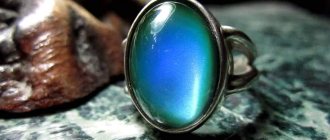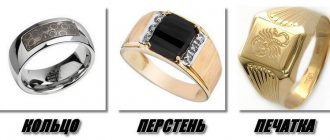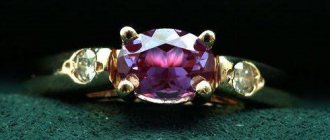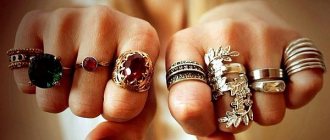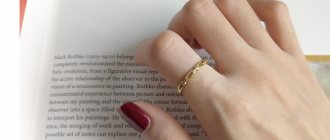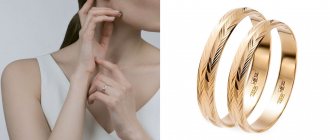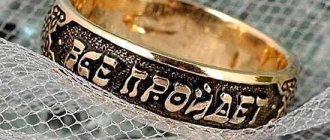Ever seen a chameleon? This lizard is a kind of curiosity of nature, but perfectly adapted to the external environment. For example, a chameleon's eyes can rotate independently of each other, looking in different directions. But most of all, this lizard became famous for another amazing ability - the ability to change the color of its skin.
This is why jewelry that can change color became known as chameleons. With a well-studied lizard, everything is more or less clear: complex chromatophore cells containing capsules with pigments are responsible for the change in color.
But why the chameleon ring changes colors is a mystery to many. Let's try to solve it together!
Gold ring with ruby in the SUNLIGHT catalog
History of appearance
Attempts to create a substance that changes color under the influence of external and internal factors have been going on for a long time. The first successful experience in this direction is associated with the name of the medieval physician and alchemist Paracelsus, who left a significant mark on the history of mankind.
According to historical data, it was Paracelsus who created the first paints that could change color. Unfortunately, the recipe for those legendary paints was lost, but with the development of natural sciences it was possible to create no less spectacular and effective samples.
Legend has it that Paracelsus managed to paint a magical landscape. In a warm room, the picture depicted a green and blooming garden, which in the cold miraculously transformed into itself, but shackled in winter and covered with snow.
The next successful attempt at experimenting with flowers was made much later, already in 1921. The German chemist Weitz discovered the unexpected property of some substances to change color under the influence of temperature. Then this phenomenon remained unexplained from a scientific point of view.
Clarity was brought into these processes by the English duo Ullman-Milke in 1962, who discovered the phenomenon of isomerism, that is, the rearrangement of the molecules of individual substances under the influence of temperatures. It formed the basis for the creation of a liquid crystal thermometer, and subsequently a mood ring that changes color depending on the state of the owner.
In the 1970s, American jeweler Marvin Wernick was looking for new approaches to jewelry design, while simultaneously studying related scientific literature. And already in 1974, he invented the so-called magic ring, the principle of which is based on a change in the molecular structure of a substance under the influence of temperature.
In 1975, the first sales of jewelry with “magical” properties began. These were mainly rings and pendants.
Probably, Wernik was not 100% American, since he did not patent his invention. Not very clean colleagues, including Joshua Reynolds, immediately took advantage of this.
Reynolds was a businessman from God: he immediately received a patent and launched an active advertising campaign for a revolutionary new product. He positioned “his” invention as a tool for biological feedback. That is, he offered the audience not just an original decoration, but some kind of indicator of a person’s mood and inner state.
Reynolds is still listed in some sources as the inventor of the chameleon ring. This is what knowing the realities of the market and instant reaction to the situation means!
Needless to say, the new product, in keeping with the current trends of the time, was enthusiastically received by consumers. In the very first year, chameleon jewelry was sold for a fabulous sum at that time - about 15 million dollars.
Innovative jewelry was rapidly gaining popularity, because instead of several multi-colored rings, adherents of the mainstream could wear one, and such an original one at that!
Nevertheless, the global fashion for “mood rings” (that is the name they were sold under) turned out to be fleeting: it lasted only a few years. The market turned out to be oversaturated, and once-trend jewelry was sold for literally pennies.
These decorations came to the expanses of the former Soviet Union in the wake of the opening of the Iron Curtain, in the rebellious 90s of the last century. The demand also did not last long: at first, the unspoiled consumer audience liked the original tchotchkes, but soon they began to look more and more closely towards more sophisticated jewelry.
Now the fashion for chameleon rings is gradually returning. Elements that change color are present in the collections of many jewelry brands. And cheap options are massively produced by Chinese manufacturers.
Why do you dream about the “Save and Preserve” ring?
Seeing a ring in a dream can interpret the sleeping person’s relationship with loved ones or lovers. Also, the ring often interprets partnerships, unions, or alliances.
A golden ring can predict immediate success, a successful deal, wealth, or the fulfillment of a wish. But silver often speaks of certain successes in work, achieving certain successes, and career advancement.
Receiving a ring in a dream means that your significant other may be planning to propose marriage. But a ring presented by a business partner means the obligatory success of this relationship, or a successful upcoming deal.
Losing a wedding ring in a dream can indicate lost love between spouses; a broken ring can indicate that the relationship between spouses has cooled, or a breakup is approaching.
If the ring darkens in a dream, this may indicate that the person has ceased to value what he has. But a rusty ring dreams of a damaged relationship. A dirty ring can be a sign of betrayal or betrayal of a loved one.
How does a chameleon ring work?
Let's figure out how the mood ring works from a scientific point of view. Contrary to the claims of marketers, their properties are based not on mysticism or bioenergy, but on chemistry, physics and biology. Let's look at this using the example of chameleon rings invented by Uernik.
As mentioned above, the action of these decorations is based on the principle of isomerism. Isomeric substances are capable of changing their molecular structure under the influence of various factors. In our case, this is temperature.
The working element of chameleon rings is a capsule filled with a liquid with isomeric properties, that is, changing color depending on temperature. This capsule is mounted on a frame base (not always) and is protected from external influences.
Scientists have long found out that under the influence of various emotions, our body temperature varies, albeit within insignificant limits. This is where a win-win marketing ploy originated: supposedly the ring changes color depending on the mood and reflects the internal experiences of the owner.
There is a certain scientific (more precisely, scientific-like) basis for this statement, and we have already talked about it. However, to definitely believe that a ring can tell about a state of love or serenity is the same as being sure that a cabbage patch can be watered with one liter of water.
Features of chameleon rings
In addition to their unusualness, rings with chameleon stones also have certain features. Let's study them further in more detail.
Material of manufacture
The base material for the manufacture of these amazing products contains a heat-sensitive element - liquid crystals. They begin to respond to changes in temperature ranging from thirty-two to thirty-eight degrees Celsius.
Jewelry production method
To obtain such a product, it is necessary to pour a liquid crystalline substance into a glass or quartz form. It is this capsule that will represent the main decorative element of the chameleon ring.
How the ring works
In fact, the action of the chameleon ring acts as a kind of medical technique that affects the human physical body. Under the influence of various diseases, metabolism and homeostasis are disrupted in the body. Certain factors set liquid crystals in motion, and different refractions of light are observed, due to which the ring changes its hue.
Doctors, based on the tone of liquid crystals, determine temperature and blood pressure. Some shades of such decoration indicate inflammatory processes or even formations.
In addition, a ring that changes the properties of its appearance based on the emotions experienced will become the simplest and easiest indicator of your mood. It has such a high sensitivity that it is able to respond to a person’s body temperature regarding his emotional experiences. It is for this reason that such jewelry was given the name “mood rings.” Included with the heat-sensitive elements are instructions that allow you to find out what a particular shade of the product will tell you.
In most cases, the chameleon ring has a universal design option. This is an ordinary product, the circumference of which is decorated with an insert made of a special material.
Both representatives of the stronger and weaker sex will be able to use this model. In addition, such an accessory will be quite appropriate both for daily wear and as a luxurious decoration for an evening look.
There are options for rings with a more intricate design, in which the heat-sensitive parts are decorated with flowers, animals or other elements.
To the positive aspects of mood rings, you can also add a fairly affordable price and ease of purchase.
What do the colors on the ring mean?
Manufacturers sometimes indicate in the instructions what the colors of the chameleon ring mean. As mentioned above, there is a certain rational link in this color gradation, but you should not take marketing tricks literally.
The mood ring can change colors over a wide range. Let's take a closer look at the most popular scale:
- Violet. The owner of the ring is happy, he is overwhelmed with positive emotions.
- Blue. The person is in normal working condition and his health is not in danger.
- Green. This color indicates self-sufficiency, inner peace and complete self-control.
- Yellow. A person is in a state of anxiety or excitement (for example, before an upcoming exam or interview). His emotional state is unstable.
- Orange. This is a sign of severe anxiety and emotional agitation. The person loses self-control more and more.
- Red. Before us is a signal of the brightest emotions, both positive and negative. It can be either passion on a cosmic scale or anger.
- Amber. The owner of the jewelry experiences hesitation before an important life choice.
- Brown. This color indicates a weak biofield, which may be associated with health problems and lack of support from loved ones.
- Grey. The owner of the jewelry experiences a severe emotional decline and is in a depressed state.
- Black. This is the most negative option of all possible: a person is practically deprived of vital energy, is in a state of depression and loss of strength.
The meaning of the colors of a chameleon ring is usually indicated in the instructions for the jewelry. They can vary significantly depending on the manufacturer.
The list described above must be treated critically, because we remember that we are dealing with some kind of temperature meter. So it is unlikely that the strongest feeling of love will cause him to blush as intensely as the owner preparing a kebab. And the brightest anger shown in winter frosts will most likely go unnoticed as a decoration.
In winter, outdoor chameleon rings most often gravitate towards a cold blue-green palette, and in severe frosts they “diagnose” the owners with severe depression and loss of strength. And in the summer they easily turn yellow, orange and red, especially if it is very hot. In general, if you go into a bathhouse with such decoration, you will definitely find yourself in a state of unearthly love or cosmic anger. At least from a decoration point of view.
In a word, the readings of chameleon rings should be treated philosophically: these are just thermometers, and not as accurate as standard ones. If the ambient temperature is normal, yellowing or redness of the ring will indicate a febrile condition. But for this, the body temperature must rise so significantly that it will be noticeable by a change in well-being.
The discrepancy between the color scales of isothermal chameleon rings and the real state of the owners put an end to their victorious march around the world. However, they still remain in demand among lovers of original and inexpensive jewelry.
The “Save and Save” ring burst, good or bad
The Christian faith came to Rus' to replace paganism. No matter how hard the Church tried to get rid of pagan signs and rituals, faith in some was still firmly entrenched among the people.
Since ancient times, it was believed that water is an excellent neutralizer of negative energy. Therefore, damaged amulets were thrown into the river.
For example, no matter how much the clergy repeat that nothing bad awaits the owner of a broken ring, there is an opinion among the people that this is unfortunate. At the same time, it is worth noting that people have found a way out of this situation. It is believed that a broken ring wards off bad luck from its owner. In this way, the man bought off the grief that awaited him with his property.
Natural chameleon stones
The phenomenon of isomerism is inherent in many substances, including natural minerals from the category of precious and semi-precious stones. This property is widely used in the refining of some natural minerals. For example, most corundums (including ruby and emerald) become more pure and intense in color when heated.
However, “heated” rubies and sapphires are quoted on the market much lower than their counterparts of natural bright color, so this method is used primarily to create fairly mass-produced (if this word is applicable here) jewelry.
An ennobled ruby will never return to its original state, therefore, when applied to precious stones, this process is considered irreversible.
However, there are also chameleon stones that change color reversibly. True, in this case we are talking only about the optical effect that arises as a result of changes in illumination and the angle of incidence of light rays. It is called "pleochroism".
Alexandrite is considered the standard of pleochroism. This is a very expensive and rare gemstone, not found in mass-produced jewelry. It can change colors over a wide spectrum: from blue-green in daylight to reddish-violet and pinkish-crimson in electric light.
In addition to the recognized king of pleochroism, alexandrite, many precious, semi-precious and ornamental stones exhibit similar properties. This category includes fancy corundum, amethyst, iolite, baddeleyite, cordierite, some varieties of topaz, tourmaline and other minerals of varying degrees of rarity and value.
The “Save and Preserve” ring turned black: why?
According to popular superstitions, a blackened ring is a harbinger of something bad. However, the negativity does not concern the owner’s personal life. Rather, misfortune can affect a person’s health.
Therefore, we recommend taking care of yourself these days:
- you shouldn’t fix something you haven’t been taught;
- do not get involved in disputes and fights;
- you should protect yourself from weather disasters;
- pay special attention to your physical and psychological state.
Nanotals Color Change
Translated from English, the phrase Color Change is translated as changing color, which reflects the essence and properties of these artificial minerals.
Artificial imitations of precious stones under the general name “nanostals” are the result of the development of Russian scientists. They are produced exclusively by the RusGems company, so far in the only factory located in the Moscow region.
Nanotals, as you might guess, appeared during the evolution of nanotechnology. They are based on high-tech processing of silicon oxide (SiO2) and aluminum (Al2O3).
The manufacturer successfully creates both almost absolute visual analogues of precious stones and artificial minerals with arbitrarily specified properties. At the moment, RusGems produces nanostones in 150 color variations, and at the request of the customer it can also create synthetic stones of other shades.
Now RusGems produces 22 categories of nanotals with the effect of pleochroism of varying degrees of severity. They have one color in natural light, but take on another color in artificial light. There are even stones that turn from green to orange, from pink to yellow, from gray to purple!
Where to buy and cost
Chameleon rings come in different types and are in completely different price ranges. The simplest option is costume jewelry at a price of about 100 rubles per piece; the price of more complex options with fancy shapes can reach 500 rubles. But gold and silver products will cost significantly more; here the price will depend on the quality and purity of the metal, the presence of precious stone inserts and other factors.
Finding jewelry on sale is not that difficult. It is available in almost any city; you should look for it in stores specializing in the sale of costume jewelry or in jewelry stores. Mood rings with the words “save and preserve” can be found in church varnishes.
Another option is to purchase a ring in an online store; some resources even offer the manufacture of such accessories to order, taking into account all the client’s wishes. The choice on the Internet is huge, and delivery is possible almost everywhere. Therefore, finding a suitable product will not be difficult, but you will not have to wait for delivery.
Changing colors - physics or mysticism
There is no special mystery about the ability of a chameleon ring to change color. The simple secret lies in the liquid crystals used in its creation. They have long been used in medical and household appliances. They are especially valued by doctors for their ability to help diagnose tumors and inflammation.
The chameleon ring can even signal changes in blood pressure. When the body temperature of the owner of the jewelry changes, the liquid crystals move, and accordingly, the light is refracted at a different angle. According to this scheme, the chameleon ring pleases us with different colors. Only physics, and no mysticism!
Product range
Decorations can be designed in different ways. In addition to classic models, the jewelry store offers modifications. Each of them has its own purpose. The most common type are headbands. Outwardly, they resemble wedding rings. Plastic, steel, silver, and nickel are used as the base. This affects the cost of the product. The color of the capsule changes gradually, the transition from one shade to another takes several minutes.
Chameleon rings can be made from Color change nanostals, natural minerals and their synthetic analogues. The frame is made of silver and gold. People who believe in God often purchase jewelry from the “Save and Preserve” series. The canonical treatment is applied around the insert or on the rim. The letters are pressed into the base.
The assortment is quite extensive. It includes children's, women's and men's options. Unisex jewelry is included in a separate category. Silver accessories often complement a business suit. For more formal occasions, luxury jewelry made from sital stones and gold is suitable. The decorations are distinguished by their original shape and have a high decorative effect.
Particularly popular are models whose shape resembles butterfly wings, the moon, geometric shapes and a flower. The most expensive option are chameleons decorated with garnets, diamonds and agates.
